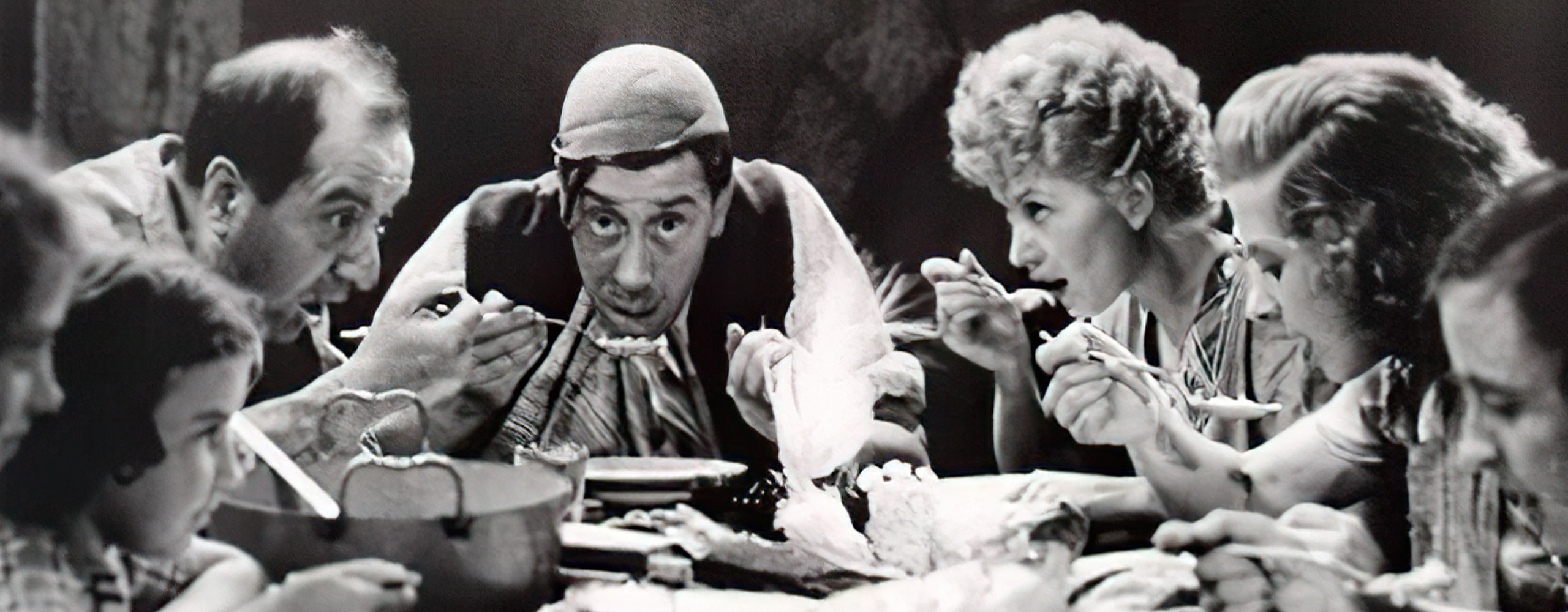COM_SPPAGEBUILDER_ADDON_ARTICLE_NO_ITEMS_FOUND
About Talking of Food
Talking of Food is a magazine website set up by a group of people who love not only food but also the diversity of its culture. It is not bound by ideology or momentary fads but has an open mind towards opposing views. Its contributors are often experts in their field and discuss wide ranging subjects such as antibiotics in the food-chain, the opposing arguments on GM food or the future of food. On a lighter note see how they make noodles in China or follow Elisabeth Luard's classic series on European Peasant Cookery.
Food in Literature: Part 03

Extracts from The Leopard by Giuseppe Lampedusa, The Bell Jar by Sylvia Plath, A Room of One's Own by Virginia Woolf, and Madame Bovary by Gustave Flaubert are Helen's choices for the third part.
The Leopard by Giuseppe Lampedusa
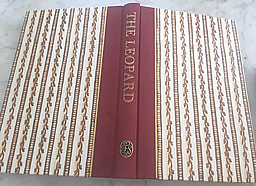 A masterpiece, set in the Kingdom of the Two Sicilies in the second half of the 19th century. The figure of the Leopard is on the family crest and is also the nickname of the head of the Salina family, the superb Prince, who reigns over the estate of Donnafugata.
However, the old noble families are finding it hard to maintain their estates and times are changing politically also. Garibaldi is campaigning to unite Italy and a new merchant class is emerging, with far more ready cash. Much of the book concerns the marriage of the Prince’s favourite nephew Tancredi, a passionate supporter of Garibaldi, to Angelica, the daughter of the greedy and vulgar mayor. Their union symbolises the new order.
A masterpiece, set in the Kingdom of the Two Sicilies in the second half of the 19th century. The figure of the Leopard is on the family crest and is also the nickname of the head of the Salina family, the superb Prince, who reigns over the estate of Donnafugata.
However, the old noble families are finding it hard to maintain their estates and times are changing politically also. Garibaldi is campaigning to unite Italy and a new merchant class is emerging, with far more ready cash. Much of the book concerns the marriage of the Prince’s favourite nephew Tancredi, a passionate supporter of Garibaldi, to Angelica, the daughter of the greedy and vulgar mayor. Their union symbolises the new order.
Food plays an important part in set pieces that describe the old order and its struggle to maintain the grandeur of past times and that highlight class differences.
We are introduced to the Salina family at dinner. They number fourteen in all, including children, tutors and governesses. The table is:
“… covered with a fine but mended lace cloth, it glittered under a powerful carcel-lamp hung precariously under the Murano chandelier…. The silver was massive and the glass splendid, bearing on smooth medallions amid cut Bohemian wear the initials FD (Ferdinandus dedit) in memory of royal munificence; but the plates, each signed by an illustrious artist, were mere survivors of many a scullion’s massacre and originated from different services. The biggest, vaguely Capodimonte, were reserved for the Prince, who liked everything around him to be on his own scale, except his wife…. Opposite his own chair, flanked by a pile of plates, swelled the silver flanks of the enormous soup tureen, with its cover surmounted by a prancing Leopard. The Prince ladled out the minestra himself, symbol of his proud duties as paterfamilias."
The following day, we read about a family lunch, regarded as the main meal of the day.
“At the end of the meal appeared a rum jelly. This was the Prince’s favourite pudding, and the Princess had been careful to order it early that morning in gratitude for favours granted. It was rather threatening at first sight, shaped like a tower with bastions and battlements and smooth slippery walls impossible to scale, garrisoned by red and green cherries and pistachio nuts; but into its transparent and quivering flanks a spoon plunged with astounding ease. By the time the amber coloured fortress reached Francesco Paulo, the sixteen year old son, who was served last, it consisted only of shattered walls and wobbly rubble. Exhilarated by the aroma of rum and the delicate flavour of the multi–coloured garrison, The Prince enjoyed watching the rapid demolishment of the fortress beneath the assault of his family’s appetite.”
Custom requires that the Prince gives a dinner for the more prominent local families and it is at one such dinner that Tancredi sees Angelica for the first time.
“The Prince was too experienced to offer Sicilian guests, in a town of the interior, a dinner beginning with soup, and he infringed the rules of haute cuisine all the more readily as he disliked it himself. But rumours of the barbaric foreign usage had reached the notables of Donnafugata too insistently for them not to quiver with a slight residue of alarm at the start of a solemn dinner like this. So when the lackeys in green, gold and powder entered, each holding a great silver dish containing a towering macaroni pie, only four of the twenty at table avoided showing pleased surprise; the Prince and Princess from foreknowledge, Angelica from affectation and Concetta from lack of appetite. … (Concetta is the Prince’s daughter, she has long been in love with Tancredi but has already realised that he has fallen for Angelica).
Good manners apart though, the aspect of those monumental dishes of macaroni was worthy of the quivers of admiration they evoked. The burnished gold of the crusts, the fragrance of sugar and cinnamon they exuded, were but preludes to the delights released from the interior when the knife broke the crust; first came a spice laden haze, then chicken livers, hard boiled eggs, sliced ham, chicken and truffles in masses of piping hot glistening macaroni, to which the meat juice gave an exquisite hue of suede” (sic).
In 1963 Visconti made a terrific film, with Burt Lancaster perfectly cast as the Prince, Alain Delon as Tancredi and Claudia Cardinale as Angelica.
This wonderful book also has one of the best endings in fiction. Many years later, the Prince has died, the estate has been sold off and Concetta, now a bitter old maid, visits the Palace for the last time. The Prince’s beloved dog Bendico had died and been stuffed and Concetta orders the servants to throw it away:
“As the carcase was dragged off, the glass eyes seemed to stare at her with the humble reproach of things discarded in the hope of final riddance. A few minutes later what remained of Bendico was flung into a corner of the yard visited every day by the dustman. During the flight down from the window its form recomposed itself for an instant; in the air there seemed to be dancing a quadruped with long whiskers, its right foreleg raised in imprecation. Then all found peace in a little heap of livid dust.”
The Bell Jar by Sylvia Plath
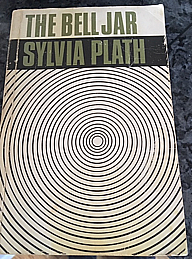 This is Plath’s only novel and it is heavily autobiographical. Esther, the heroine, is one of 1 dozen young women who win a writing competition, set by a woman’s magazine called “Ladies Day”. The prize is a month’s holiday with work experience, all expenses paid, in New York. The magazine’s Food Testing Kitchens lays on a banquet lunch for them.
This is Plath’s only novel and it is heavily autobiographical. Esther, the heroine, is one of 1 dozen young women who win a writing competition, set by a woman’s magazine called “Ladies Day”. The prize is a month’s holiday with work experience, all expenses paid, in New York. The magazine’s Food Testing Kitchens lays on a banquet lunch for them.
“Arrayed on the Ladies Day banquet table were yellow-green avocado pear halves stuffed with crabmeat and mayonnaise, and platters of rare roast beef and cold chicken, and every so often, a cut-glass bowl heaped with black caviar. I hadn’t had time to eat any breakfast at the hotel cafeteria that morning, except for a cup of over stewed coffee so bitter it made my nose curl, and I was starving.
Before I came to New York I'd never eaten out in a proper restaurant. I don’t count Howard Johnson’s where I only had French fries and cheeseburgers and vanilla frappés with people like Buddy Willard (the boyfriend she’d left behind). I’m not sure why it is but I love food more than just about anything else. No matter how much I eat, I never put on weight. With one exception I’d been the same weight for ten years.”
Before lunch they had been given a tour of the kitchens:
“… the sight of all that food stacked in those kitchens made me dizzy. It’s not that we hadn’t enough to eat at home, it’s just that my grandmother always cooked economy joints and economy meat–loafs and had the habit of saying, the minute you lifted the first forkful to your mouth, “I hope you enjoy that, it cost forty-one cents a pound,” which always made me feel I was eating pennies instead of Sunday roast.”
She strategically eyes the placing of the bowls of caviar to estimate her best chances of getting the most to eat. She had tasted tiny quantities of it at home and:
“… by the age of nine I had developed a passionate taste for cold vichyssoise and caviar and anchovy paste.
“Under cover of the clinking of water goblets and silver ware and bone china, I paved my plate with chicken slices. Then I covered the chicken slices with caviar thickly as if I were spreading peanut butter on a piece of bread. Then I picked up the chicken slices in my fingers one by one, rolled them so the caviar wouldn’t ooze out and eat them.
I’d discovered this after extreme apprehension about what spoons to use, that if you do something incorrect at table with a certain arrogance, as if you knew perfectly well you were doing it properly, you can get away with it and nobody will think you are bad mannered or poorly brought up. They will think you are original and very witty.”
Nobody seems to notice how much she is eating, so Esther becomes more confident.
“When I finished my first plate of cold chicken and caviar, I laid out another. Then I tackled the avocado and crabmeat salad. Avocados are my favourite fruit. Every Sunday my grandfather used to bring me an avocado hidden at the bottom of his briefcase under six soiled shirts and the Sunday comics. He taught me how to eat avocados by melting grape jelly and French dressing together in a saucepan and filling the cup of the pear with the garnet sauce. I felt homesick for that sauce. The crab meat tasted bland in comparison.”
She finishes off this huge lunch with a double helping of meringue and brandy ice cream and rinses her fingers in a finger bowl. Fortunately Esther had come across finger bowls before, when she had been invited to the home of a wealthy benefactress of her college, who had endowed the scholarship that she had won.
“That was where I saw my first finger bowl. The water had a few cherry blossoms floating in it, and I thought a it must be some clear sort of Japanese after dinner soup and ate every bit of it, including the crisp little blossoms. Mrs Guinea never said anything and it was only much later, when I told a debutante I knew at college about the dinner, that I learned what I had done.”
Later that day all the girls come down with awful food poisoning, caused not by the caviar but by the bland tasting crab.
“I had a vision of the celestially white kitchens on Ladies Day stretching into infinity. I saw avocado pear after avocado pear stuffed with crab meat and mayonnaise and photographed under brilliant lights. I saw the delicate pink-mottled claw-meat poking seductively through its blanket of mayonnaise and the bland yellow pear cup with its rim of alligator green cradling the whole mess. Poison.”
A Room of One's Own by Virginia Woolf.
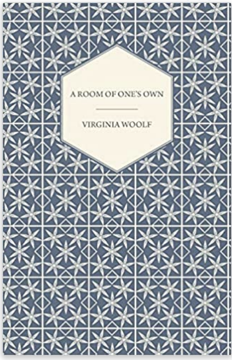 In this talk, delivered to some of the first female undergraduates at Newnham, Cambridge, Virginia Woolf contrasts the food provided at one of the male colleges, with the dinner she had tried to eat at Newnham.
In this talk, delivered to some of the first female undergraduates at Newnham, Cambridge, Virginia Woolf contrasts the food provided at one of the male colleges, with the dinner she had tried to eat at Newnham.
“It is a curious fact that novelists have a way of making us believe that luncheon parties are invariably memorable for something very witty that was said, or for something very wise that was done. But they seldom spare a word for what was eaten. It is part of the novelist’s convention not to mention soup and salmon and dumplings, as if soup and salmon and ducklings were of no importance whatsoever, as if no one ever smoked a cigar or drank a glass of wine.”
“The lunch on this occasion began with soles, sunk in a deep dish, over which the college cook had spread a counterpane of the whitest cream, save that it was branded here and there with brown spots, like the spots on the flanks of the doe. After that came the partridges, but if this suggests a couple of bald, brown birds on a plate you are mistaken. The partridges, many and various, came with all their retinue of sauces and salads, the sharp and the sweet, each in its order; their potatoes, thin as coins but not so hard; their sprouts, foliated as rose buds but more succulent. And no sooner had the roast and its retinue been done with then the silent serving man, the Beadle himself perhaps in a milder manifestation (he had earlier in the day officiously ordered her to keep off the grass, which was reserved for male Fellows only) set before us, wreathed in napkins, a confection which rose all sugar from the waves. To call it a pudding and so relate it to rice and tapioca would be an insult. Meanwhile the wine glasses had flushed yellow and flushed crimson; had been emptied; had been filled. And thus by degrees was lit, half way down the spine, which is the seat of the soul, not that hard little electric light which we call brilliance, as it pops in and out upon our lips, but the more profound, subtle and subterranean glow, which is the rich flame of rational intercourse.”
Here is her description of dinner at the female college:
“Here was my soup. Dinner was being served in the great dining–hall. Far from being spring, it was in fact an evening in October. Everybody was assembled in the big dining-room. Dinner was ready. Here was the soup. It was a plain gravy soup. There was noting to stir the fancy in that. One could have seen through the transparent liquid any pattern there might have been on the plate itself. But there was no pattern. The plate was plain. Next came beef with its attendant greens and potatoes — a homely trinity suggesting the rumps of cattle in a muddy market, and sprouts curled and yellowed at the edge, and bargaining and cheapening, and women with string bags on a Monday morning. There was no reason to complain of human nature’s daily food, seeing that the supply was sufficient and coal miners doubtless were sitting down to less. Prunes and custard followed. And if anyone complains that prunes, even when mitigated by custard, are an uncharitable vegetable (fruit they are not), stringy as a miser’s heart and exuding a fluid such as might run in a miser’s veins who have denied themselves wine and warmth for eighty years and yet not given to the poor, he should reflect that there are people whose charity embraces even the prune. Biscuits and cheese came next, and here the water jug was liberally passed round, for it is in the nature of biscuits to be dry and these were biscuits to the core. That was all. The meal was over.”
She went on to say:
“The human frame being what it is, heart body and brain all mixed together and not contained in spate compartments, as they will be no doubt in another million years, a good dinner is of great importance to good talk. One cannot think well, love well, sleep well, if one has not dined well. The lamp in the soul does not light on beef and prunes.”
One hundred years after the founding of Newnham, Nicola Beauman, the owner of Persephone Books, arranged a weekend there. For dinner she saw that we were fed a thick, creamy parsnip soup with cheese croutons, beef Wellington and prune compote, made with more cream, with shortbread, accompanied by first class wine of both colours.
Madame Bovary by Gustave Flaubert.
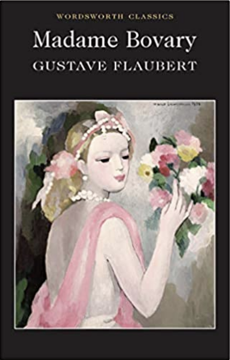 Emma’s tragically doomed marriage begins with the wedding breakfast.
Emma’s tragically doomed marriage begins with the wedding breakfast.
“The table was laid under the cart shed. On it were four sirloins, six chicken fricasées, stewed veal, three legs of mutton, and in the middle a fine roast sucking pig, flanked by four chitterlings with sorrel. At the corners were decanters of brandy. Sweet bottled cider frothed round the corks, and all the glasses had been filled to the brim with wine beforehand. Large dishes of yellow cream, that trembled with the least shake of the table, had designed on their smooth surface the initials of the newly wedded pair in nonpareil arabesques. A confectioner at Yvetot had been entrusted with the tarts and sweets. As a he had only just set up in the place, he had taken a lot of trouble, and at dessert he himself brought in a set dish that evoked loud cries of wonderment. To begin with, at its base there was a square of blue cardboard, representing a temple with porticoes, colonnades and stucco statuettes all round, and in the niches constellations of gilt paper stars; then on the second stage was a dungeon of Savoy cake, surrounded by many fortifications in candied angelica, almonds, raisins and quarters of oranges; and finally, on the upper platform, a green field with rocks set in lakes of jam, nutshell boats, and a small Cupid balancing himself in a chocolate swing whose two uprights ended in real roses for balls at the top.”
Emma has married her country doctor husband because she is desperate to leave home and improve her social standing and he is the best she thinks she can do. However she soon realises that she can’t love poor Charles, that she is bored stiff and she vehemently believes she is destined for and entitled to a great love and a life of luxury. When the Marquis D’Andervilliers invites the doctor and his wife to a formal dinner, Flaubert uses food as one way of comparing the spontaneous and naïve society that Emma has been used to, with the formality and sophistication of the aristocracy.
“Emma, on entering, felt herself wrapped round by the warm air, a blending of the perfume of flowers and of fine linen, of the fumes of the viands, and the odour of the truffles. The silver dish covers reflected the lighted wax candles in the candelabra, the cut crystal covered with light steam reflected from one to the other pale ray; bouquets were placed in a row the whole length of the table; and in the wide-bordered plates each napkin, arranged after the fashion of a bishop’s mitre, held between its two gaping folds a small oval-shaped roll. The red claws of lobsters hung over the dishes; rich fruit in open baskets were piled up on moss; there were quails in their plumage; smoke was rising; and in silk stockings, knee breeches, white cravat and frilled shirt, the steward, grave as a judge, offering ready carved dishes between the shoulders of the guests, with a touch of the spoon gave you the piece chosen. On the large stove of porcelain inlaid with copper baguettes the statue of a woman, draped to the chin, gazed motionless at the room full of life. Iced champagne was poured out. Emma shivered all over as she felt it cold in her mouth. She had never seen pomegranates nor tasted pineapples."
After dinner there is dancing and then supper:
"… with plenty of Spanish and Rhine wines, soups à la bisque and au lait d’amandines, puddings à la Trafalgar and all sorts of cold meats with jellies that trembled in their dishes.”
Featured posts
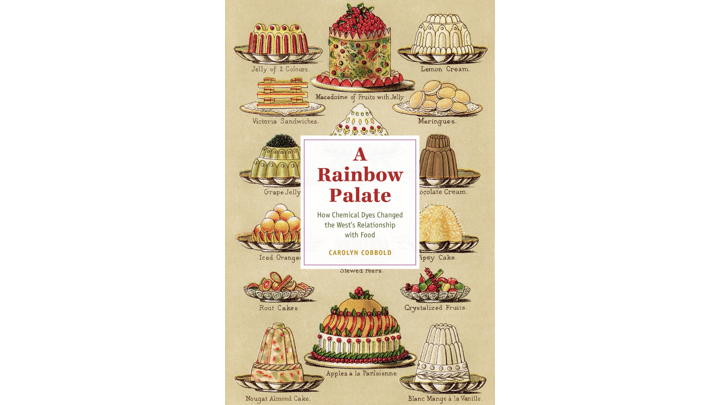
A Rainbow Palate: How Chemical Dyes Changed the West's Relationship with Food
If you opened a can of baked beans to discover a brown gloopy sauce containing brown haricot beans, rather than the orange-red sauce and beans you were expecting, what thoughts would run through your head?
Dr Carolyn Cobbold’s research interests are science and food in the nineteenth and twentieth centuries. She has recorded two extracts from her book A Rainbow Palate: How Chemical Dyes Changed the West’s Relationship with Food for Talking of Food
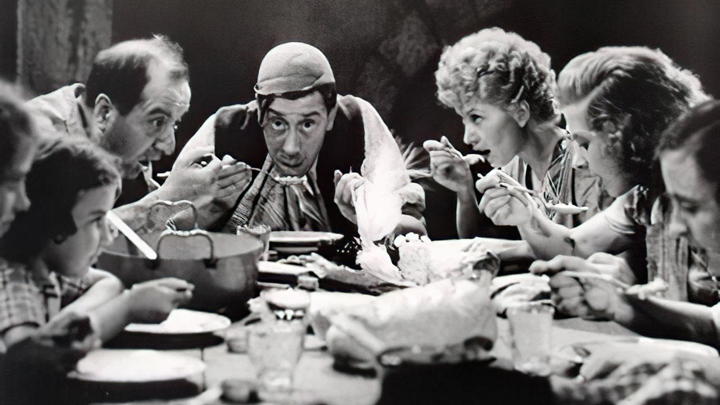
Announcement
Talking of Food has moved
Although the site has migrated to the new server, there is still work to be done and some of the content of the site will still be unavailable for a while.

Nicholas Culpeper: The Complete Herbal
Not only do many modern medicines have their origins in herbal medicine, more and more people are turning to herbal preparations—with or without also accepting modern drugs, vaccines and medications—and alternative, traditional treatments are popular. At Talking of Food we have our series on Vitamins, so we have decided to look into one of the most celebrated of herbalists, Nicholas Culpeper.

